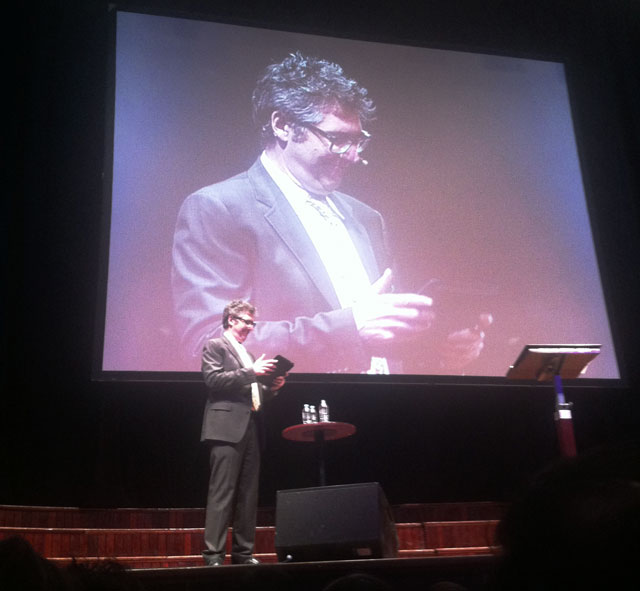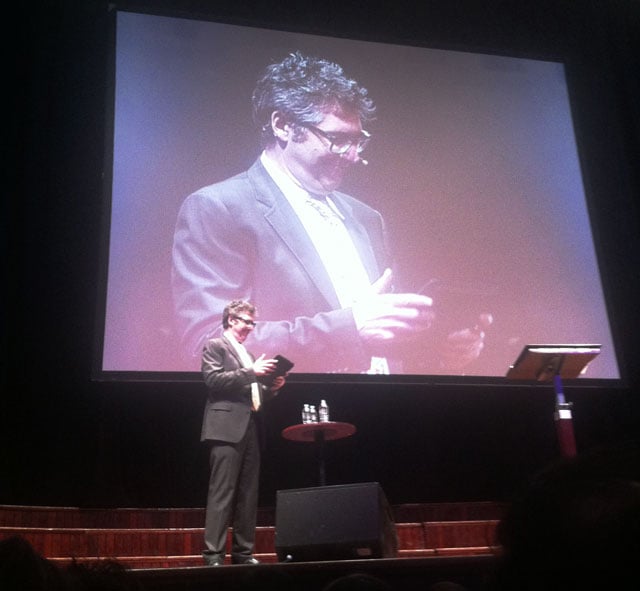Ira Glass on storytelling

Basic curiosity is one reason why I love the radio programme This American Life, but it's also because of the expert storytelling craft of the host, Ira Glass, and his fellow producers.
It was this storytelling craft that Ira Glass spoke of during his sold-out Sydney Festival shows in January of 2012. Ira does a lot of what we as designers seek to do in our everyday work lives: communicate meaning through storytelling. I was therefore very happy that he decided in Sydney to tell stories about how to tell stories. It was a great opportunity to learn some tips from a very talented and seasoned storyteller.
One man on stage with an iPad
Ira's show began in complete darkness as he wanted us to get the feeling of what it's like to listen to stories on the radio where you are not distracted by the visual. After the lights went on, Ira charmed the audience with background stories about the radio show, using an iPad to weave audio clips and soundtracks in and out of his dialogue. He told us many anecdotes which described his view on what makes a good story, I've captured some of them here.
People need resolution
People will continue to listen to a story if they feel as though something is about to happen. When we hear a sequence we want to hear how it ends. This relates to our need as humans for closure (hello Gestalt theory).
Ira reminded us of the story of the Arabian Nights, where Scheherazade initially postpones then stops her execution by telling her mariticidal husband Shahryār a never ending story each night. Rather than killing her in the morning he needs to keep her alive to tell him the rest of the story. Storytelling as life insurance.
Ira said that every 'proper' story is like a detective story where pleasure is gained from seeing the mystery solved. Narrative suspense is what keeps us hanging on, so it's important to structure the story with this in mind.
To help structure a story with narrative suspense, Ira's tip was to get the person you are interviewing to walk you through the story bit by bit by asking them "and then what happened?".
Reflection is important for understanding
Once the action part of a story is told, Ira said that it's good to get people to reflect on what has just happened and how they feel about it. This might be done naturally by the person telling the story or you might have to draw it out of them. To do this, ask the person what is the 'universal something' that the action is all about.
The power of the visual
Ira loves an incredibly visual story. I guess this is incredibly important on radio as you need to hear the words to imagine the story. In fact, one of my favourite programmes about the visual arts is on the radio. It shouldn't work, but it does.
Visual stories contain descriptive details about all manner of people, locations and objects in a scene. Ira says not to scrimp on visual detail as helping your audience imagine context helps them to understand the story. What does the room look like, what time of day is it, what is the person wearing?
Then she said "…"
Another of Ira's tips for storytelling is to ask the person you are interviewing to verbalise the dialogue. He says that people have an amazing ability to use dialogue to add drama and detail to their stories. By way of example, he described how his wife does an amazing accent when telling a story, but can't replicate that accent when asked to repeat it without the story. Having the dialogue also means you will hear the story in close to real time, something that can only add to the impact.
Good ideas don't just happen
The common idea about creative work, said Ira, is that you are walking down the street and you get sprinkled with fairy dust. But it's not like that. Creating ideas is a job and it's hard work with a defined process to it. Ira and the team at This American Life do a lot of work to gather the great stories they tell on the radio. For every story they produce, there are many that fall by the wayside. As he said so eloquently: "Harnessing luck as an industrial product means you have to walk around a lot in the rain waiting for lightning to strike".
Listening to stories gives you empathy
Imagining yourself as one of the characters of a story is one way of practising empathy, said Ira. I think this is one of the most important links between what Ira as a storyteller does and what we do here at Meld. We do lots of user research and then we tell their stories to the client so that they can empathise with the needs of their customers. Without empathy, customer centered design is just lip service.
If you'd like to hear Ira talk more about storytelling you can watch this video on Vimeo: Ira Glass on Storytelling.

